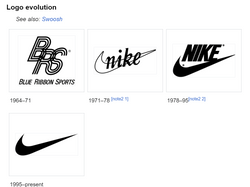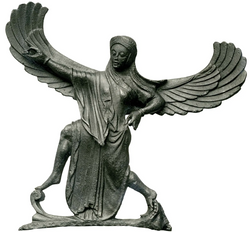May 21, 2024
History: The Origin of Nike

Founding and Early History
The global sportswear giant traces its origins to 1962, when former University of Oregon track-and-field athlete Phil Knight toured the Onitsuka (now Asics) factory in Japan and was impressed by the firm’s quality and speedy production. The trip led to a deal to distribute the Onitsuka Tiger, the company’s signature shoe, in the United States. By 1964, Knight and his former University of Oregon coach, Bill Bowerman, formed Blue Ribbon Sports; they created the iconic Tiger Cortez in 1967, their version of the Onitsuka Tiger.
In 1971, Blue Ribbon split with Onitsuka; and the duo changed the firm’s name to Nike, after the Greek goddess of victory. Its “swoosh” logo—which became one of the world’s most recognized brand logos—was also introduced that year. Carolyn David, a Portland State University design student, charged $35 for the logo, although Knight eventually gave her 500 shares of stock in 1983.
Glossary:
After: like (similar to)
Swoosh Logo History
The Swoosh is the logo of American sportswear designer and retailer Nike. Today, it has become one of the most recognizable brand logos in the world, and the most valuable, having a worth of $26 billion alone.
The Nike Swoosh corporate trademark was created in 1971 by Carolyn Davidson while she was a graphic design student at Portland State University. Davidson started as a journalism major but switched to design after taking a design course to "fill an empty elective". She attained a bachelor's in graphic design in 1971. It was here that she met Phil Knight, who was at the time teaching accounting classes at the university.
Knight had overheard that Davidson was in search of extra funds for her to take oil painting classes, so he offered to pay Davidson to do some freelance work for his company, then named Blue Ribbon Sports (BRS). Knight offered to pay Davidson $2 per hour (equivalent to $15 per hour in 2023) for the work that she completed. For seven years after its founding in 1964, BRS primarily imported Onitsuka Tiger brand running shoes from Japan. In 1971, Knight decided to launch his own brand of shoes, which would first appear as cleated shoes for football or soccer, and had a factory in Mexico ready to make the shoes.
All Knight needed was a "stripe"—the industry term for a shoe logo—to go with his new brand, so he approached Davidson for design ideas. He had asked Davidson to make sure the stripe conveyed motion and did not look similar to the three stripes of Adidas. Over the ensuing weeks, she created at least a half-dozen marks and gathered them together to present to Knight, Bob Woodell and Jeff Johnson (two BRS executives) at the company's home office, at the time located in Tigard, Oregon.
Glossary:
Cleated Shoes: shoes with points on the bottom worn for sports

Swoosh Logo History
They ultimately selected the mark now known globally as the Swoosh, a shape inspired by the wings of the Greek goddess Nike. "Well, I don't love it", Knight told her, "but maybe it will grow on me." Once the choice was made, Davidson asked for more time to refine the work she had done on the Swoosh; however, Knight stated that the company had production deadlines to meet and needed the logo as soon as possible. For her services, the company paid her $35 (equivalent to $263 in 2023) citing that she worked 17.5 hours on creating the Swoosh, although Davidson said that she is certain she worked more hours on the design. The Swoosh was officially trademarked on June 18, 1971 and in June 1972, at the U.S. Track and Field Olympic Trials in Eugene, Oregon, Nike's first official track shoe, the Nike Cortez, was released to the athletes sporting the new Swoosh.


Strategic and Competitive Advantages
Nike’s success has been tied to its ability to blend product innovation and marketing savvy to develop deep ties between its products and its customers.
Innovative marketing. The “Just Do It” slogan focuses not on the glory of winning, but the hard work and daily struggle of putting in the effort no matter what. That philosophy is psychological and applies beyond the world of sports to any goal. Nike’s imagery enhances the slogan, focusing on everyday people overcoming obstacles and embracing positions that are seemingly at odds with the status quo.
Quality and style. Nike backs up its marketing with quality products and continuous design experimentation, seeking to strike a balance between what consumers want and the functional needs of athletes. Each product division is positioned as a unique offering to build loyalty within a particular sport. Nike’s marketing and product offerings give credence to each other. For example, a marketing focus on struggles that women athletes face helps promote its products designed specifically for women’s bodies.
Audience focus. Nike has an expansive, insight-driven, customer-centric strategy centered in sport and youth culture. It focuses on the shopping experience and personalization to build brand loyalty. Nike was early to adopt online sales and invested in digital technology that provides even more insight into its customers’ changing needs.
Strategic expansion. Nike’s acquisitions focused on products core to its mission and allowed it to expand from footwear to include apparel and fitness with apps and equipment that help the company reach not just athletes, but anyone looking to lead a healthier lifestyle.
Glossary:
Savvy: know, understand, make good judgement
Imagery: visually descriptive or figurative language, especially in a literary work.
at odds: in a state of disagreement
status quo: the current state of things, existing state
strike a balance: choose a moderate course or compromise.
credence: acceptance
By undefined
9 notes ・ 5 views
English
Upper Intermediate